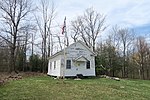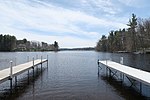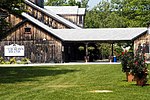Big Pond (Massachusetts)
Buildings and structures in Berkshire County, MassachusettsBuildings and structures in Hampden County, MassachusettsLakes of Berkshire County, MassachusettsLakes of Hampden County, MassachusettsLakes of Massachusetts ... and 2 more
Tourist attractions in Berkshire County, MassachusettsTourist attractions in Hampden County, Massachusetts
Big Pond (The Place To Be) is a 330-acre (1 km2) lake located in Otis, Massachusetts. The lake is popular for boating, swimming, fishing, water skiing, snowmobiling, camping, and water-related recreation. Fish include lake trout, bass, white perch, yellow perch, catfish, and bluegills. Big Pond is stocked with trout by the Massachusetts Division of Fisheries & Wildlife.The Big Pond Association (www.bigpondassociation.com ) is a 501c3 non-profit that oversees a number of activities throughout the year. In addition, the association has an active weed watcher program to identify invasive plant species and raises awareness of the threat.
Excerpt from the Wikipedia article Big Pond (Massachusetts) (License: CC BY-SA 3.0, Authors).Big Pond (Massachusetts)
Pond Boulevard,
Geographical coordinates (GPS) Address Nearby Places Show on map
Geographical coordinates (GPS)
| Latitude | Longitude |
|---|---|
| N 42.1934313 ° | E -73.0419565 ° |
Address
Pond Boulevard 6
01029
Massachusetts, United States
Open on Google Maps








